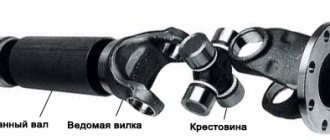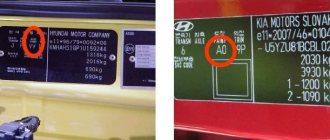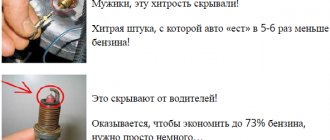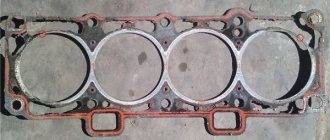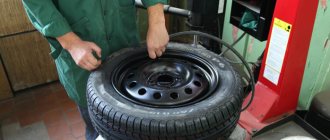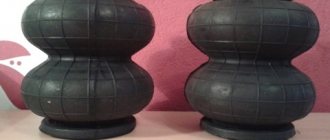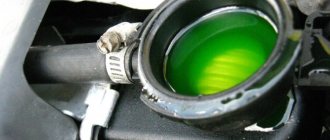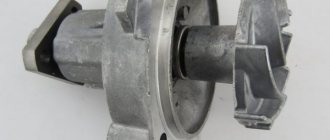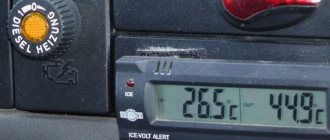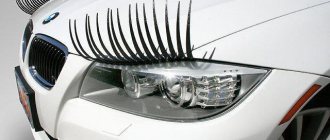All about balancing cardan shafts with your own hands. Important points and recommendations
What is it - balancing cardan shafts with your own hands, and “what do you eat it with,” as they say?
Probably, few of the average car enthusiasts have seriously faced this issue for real. Although for owners of used cars with a driveshaft, one way or another, problems with vibration or an unpleasant hum in this area sometimes come to light. For those who do not yet attach the necessary importance to the transmission parts (well, it hums and vibrates - so what): an experienced mechanic will probably tell you what the dangers of such an imbalance of the cardan are. And this problem, which seems not so important to many, can lead to disastrous consequences: rapid wear of the transmission in particular, and the entire car as a whole.
What is driveshaft balancing and when is it necessary?
There can be several reasons for the occurrence of an imbalance in cardan shafts, ranging from manufacturing defects in specific parts to deformation of the shafts. Moreover, each of the reasons can upset the balance of the cardan and lead to undesirable consequences.
The balancing of the driveshaft can be disrupted during repairs by inadvertently turning the driveshaft 180 degrees. In order to avoid such troubles, experts put marks on sliding forks and splined bushings. In addition, the cardan transmission has certain torque limitations in the transmission angles. Torque angles of up to 20 degrees are considered optimal. The highest efficiency can be achieved precisely with such indicators. If the transmission angle is higher than this value, this may negatively affect the operation of the hinges.
In addition, a simple universal joint with a cross and large angles will not be able to ensure consistently uniform rotation of the driven shaft. Like wheels, driveshafts can be unbalanced; by the way, this is one of the most dangerous phenomena that affects driveshafts, as well as all rotating parts.
Imbalance can be identified by characteristic unnatural vibrations. It is a mistake to believe that imbalances are just unpleasant sensations. An imbalance of the driveshaft is accompanied by mechanical loads, which in turn lead to intense wear of the hinges and other associated transmission elements.
At a service station, the imbalance of the driveshaft is determined using special equipment. This malfunction can be treated by installing balancing plates on the pipe, as well as by placing special spacers for balancing, which are placed under the locking covers of the cross bearings. Sometimes the problem is solved by removing metal from special bosses on the flange forks.
Balancing of driveshafts, as a rule, is carried out as an assembly with hinges. The gaps in the joints of the spline and cross have a great influence on the magnitude of the imbalance. If during the manufacture of cardan shafts it is still possible to maintain the size of the gaps, then in further operation, as well as during repair work on the cardan shaft, due to significant wear of the seats and the splined part, it is quite difficult to ensure this. Therefore, after carrying out any repair work related to the driveshaft or simply removing it, it is necessary to carry out balancing.
What is driveshaft balancing and when is it necessary?
Please rate this page
Content
Balancing driveshafts with your own hands can be comparable to balancing wheels. In practice, driving a car with unbalanced tires is possible (and many careless drivers take advantage of this). But the problems and material costs associated with this, believe me, are not worth it. It’s better to hang the weights on time. And most likely, do a complete wheel alignment of your chassis.
To prevent it from being pulled to the side when driving
, the wheels did not feel beating when accelerating. Of course, an important place is also occupied by the issue of a comfortable ride, from which you enjoy, and do not swear after each “difficult” kilometer. In addition, in the end, with such a long enough ride, worn out and beaten tires have to be changed. And this can cost a lot.
Causes and symptoms
Let's get back to our cardans! There can be many reasons for the malfunction and imbalance of these devices. The most basic: wear and tear during long-term use, manufacturing defects, mechanical deformations caused by impacts. Another reason is that the gaps between the elements of which it consists are too large.
If, for example, you repaired a cardan or installed a new one. There is also a need to perform balancing when installing a used shaft.
What are the signs that the driveshaft is out of balance? The main thing is to increase the level of vibration when the car is moving until it is clearly felt by the driver and passengers. Additionally, a clearly audible hum may appear, accompanying the vibration of the housing.
Signs that your driveshafts need balancing
Important! You can determine that the driveshaft requires balancing by the vibration that occurs in the vehicle's chassis when driving. Moreover, if the degree of this vibration increases in proportion to the increase in the speed of the machine, then with a high degree of probability we can say that the cardan is to blame. The vibration accompanied by a characteristic hum will be another confirmation of this.
The degree of imbalance and, most importantly, its cause can only be shown by diagnosing this element. If the misalignment is large enough and is caused by mechanical damage or serious wear of any of the driveshaft components, it must be replaced. And only after this the updated mechanism is sent to a balancing stand - first, each part separately, and then the entire mechanism as a whole.
Folk method
As soon as you begin to feel vibrations that seem too strong and unnecessary, and getting to a service station is not possible - due to time or money - you can balance the cardan with your own hands. Fortunately, folk craftsmen have long developed a rather labor-intensive but effective method. To do this, we conditionally divide our cardan into 4 equal parts with an imaginary cut across (this operation should be performed in a garage on a pit or on an overpass). Next, we take a small weight (lead or alloy, like for balancing a wheel) 30 grams.
We attach it rigidly to the first part of the cardan
. The next stage will be testing. To do this, you need to drive out onto a smooth, level road and listen for vibrations: have they become more or less? We return back to the garage and attach the weight to the next part of the part. We are testing. Let's go back. This operation must be performed with each part of the cardan.
To be more confident, you can try breaking the part into more parts. So, you have already decided (by experience) on the cardan sector. Now all that remains is to decide on the weight of the weight.
If you have ordinary electrode welding, you can weld with it. Thus, we will get an approximately balanced shaft that will not vibrate excessively when driving, and will serve you for quite a long time. It is fair to note, however, that this labor-intensive process does not relieve us of the need, in the end, to contact the service for more thorough repairs. But, for a while, you will almost forget about vibration and keep the accompanying transmission parts intact.
Technological method
When the cardan shafts have been balanced with your own hands, which gives the driver some respite - collect some money, gather your thoughts, and after a certain time, go to the service station anyway. Here you will have your car checked on a balancing stand using sensors, the working elements of which touch the “control surfaces” of the cardan.
The scheme is simple:
the shaft rotates and the working element moves, showing us an imbalance in a specific section.
The data is processed and displayed on the monitor using a specially developed computer program. Moreover, checking in this way does not involve removing the cardan itself.
Subsequent compensation for the found imbalance is carried out in several ways:
installation of balance plates directly on the cardan itself, installation of gaskets, removal of metal (in extreme cases, in case of factory deformation, for example, of a part).
How is balancing done?
Balancing a cardan on a car is a labor-intensive process consisting of several stages, each of which is important in its own way:
- Using a special machine, the cardan is tested, thereby identifying the main causes of the malfunction, as well as the places that affect the imbalance of the chassis.
- Next, the craftsmen alternately attach weights to each side of the shaft to measure the indicators. The procedure helps to more accurately determine the degree of deviation from the norm.
- After this, the shaft is rotated 180 degrees, after which the above procedure is repeated again.
- The data obtained during testing is used for the balancing stage, which is the final stage.
Important! In a service station, the diagnostic process is carried out with the highest quality possible, since specialists use the latest equipment that is not available in a regular garage. Data is calculated down to every millimeter, because perfect balancing accuracy is a guarantee of quality service. Moreover, the work itself takes no more than half an hour!
Video of cardan balancing in the garage
The higher the angular velocity of the part, the greater the likelihood of its imbalance, and vibration can be eliminated only and exclusively on complex balancing machines. Moreover, the larger the part, the more complex the equipment should be. Balancing the driveshaft with your own hands, video attempts of which we presented below, as a rule, gives only psychological results, but by no means real ones.
The fact is that it is possible to eliminate the balance of the cardan transmission only if the location and weight of the imbalance are accurately verified, and the cardan must be balanced exclusively in the assembly with the crosspieces. In a garage and without balancing equipment, this is only possible with a cardan installed on the car. Technologically this is impossible to accomplish. Eliminating the imbalance itself is a matter of five minutes, but the main thing is to calculate the exact location, cause and eliminate it.
How to balance a cardan on a car
In parallel with balancing the cardan, the master visually inspects all its components in order to determine the degree of wear of each part and the possibility of their further use. The most common malfunction that can be detected is wear (thinning) of the splines. Further use of such parts is fraught with very serious damage, so it is better to replace them to avoid big problems.
Numerous videos about balancing cardans show that during this operation, additional parts are “hung” onto the cardan installed on the stand. These are so-called balancing plates, with the help of which the driveshaft is subjected to pressure that simulates the operating conditions of the unit. The stand itself is in many ways reminiscent of a lathe: in the process of unwinding a part fixed on it, its imbalance (if any) is revealed, so the master can only get rid of it by grinding off a thin layer of metal from the surface of the shaft with a special cutter.
Important! It is possible to achieve the required degree of accuracy in balancing a driveshaft only in a car service center - for this you need both the stand itself and special measuring equipment. Although technologically this procedure is not particularly difficult for an experienced master, it is not recommended to perform it on your own.
Do not forget that an insufficiently centered cardan will not only cause vibration in the chassis of the car while it is moving, but will also lead to accelerated wear of the entire transmission.
What is an imbalance and how to eliminate it
The main sources of vibration in a car are large parts with high angular velocity, namely: the driveshaft, automatic transmission torque converter, wheel, crankshaft and flywheel with clutch assembly. If the center of mass of a part does not coincide with the longitudinal axis along which the part rotates, an imbalance will inevitably occur. From a physics point of view, imbalance is the product of the weight of the part and the mass of the eccentricity.
Balancing the driveshaft is the only effective method for removing imbalance. To eliminate it, it is necessary to attach a load to the cardan that is equal in weight, but opposite in sign to the eccentricity. In this case, it is very important to maintain the coincidence of the axes and the location of the suspensions when balancing with the axes and suspension points in real working conditions. In cases with those parts whose length is significantly less than the axis of rotation (wheel, flywheel), it is enough to hang the part by only one point, which greatly simplifies the balancing work. It is also necessary to take into account that the rolling resistance at the suspension point should be minimal and the accuracy of determining the location and module of the imbalance often depends on this. The part simply rotates and stops at the place where the unbalance point is at the bottom. All that remains is to simply mark this point and install a correction weight, and then repeat the operation.
Features of balancing the cardan drive
In the case of a cardan shaft, we are dealing with a part whose length significantly exceeds its diameter, and the imbalance may have the same module, but a different direction vector. This is called moment imbalance and can only be calculated using driveshaft balancing equipment. Such vibrations can only be treated with dynamic balancing, which requires calculating and eliminating several imbalances at once.
An imbalance of the cardan can occur not only due to its damage, but also in some other cases:
factory defects (different cardan pipe wall thicknesses, poor-quality and incorrect fixation of the lugs);
the occurrence of gaps in the cardan transmission elements;
curvature of the shaft itself;
In addition, in most cases, dynamic balancing of the new cardan is necessary, and after each repair, the cardan shaft must be balanced. The price of this operation in special centers depends on the car model, and the approximate cost of the work is given in the table.
Balancing stages
Methods for eliminating cardan shaft imbalance depend on the cause of its occurrence, and are performed in our technical center by experienced professionals using high-precision special equipment. For example, balancing the shafts of domestic cars can be done by:
- installation of balancing plates;
- removing the required layer of metal from the bosses on the flange forks;
- installing gaskets under the locking bearing caps on the crosspiece.
More detailed information about balancing driveshafts in those can be obtained by phone or on the center’s website.
How to balance a driveshaft yourself
Based on the information received, it is clear that without special equipment there can be no talk of any precise balancing. However, if a situation arises where it is necessary to carry out balancing, but there is no such workshop nearby, as a temporary measure you can do the following:
the cardan is conventionally divided in the longitudinal plane into 6-8 parts;
a weight (15-30 g) is attached to each of the sectors in turn; this can be a weight for balancing wheels;
the car is taken out onto a flat road and a check is carried out to determine whether the vibration has been eliminated or has become even greater;
After this, the cargo is moved to another sector.
It is clear that this method will only remove the main imbalance and in no way claims to be accurate, but it will allow you to get rid of vibrations for a while and get to the service station. Make sure the rotating parts are balanced and enjoy your travels!
Balancing the driveshaft
There are several possible reasons for the negative change. First of all, this may be due to the initial incorrect adherence to the exact dimensions of individual parts
The entire design of the driveshaft consists of several elements located on the same axis. In this regard, it is very important that this part is always in a state of balance. If this condition is violated, the remaining components of the automobile transmission will experience serious load. In the future, the imbalance can lead to failure of not only the cardan transmission, but also other components of the machine.
Why is it necessary to balance the driveshaft?
Cardan balancing may be required in several cases:
- The installed mount and parts on the base cardan do not meet modern quality standards, or have failed after the warranty period has expired.
- Improperly performed balancing with your own hands, coupled with poor-quality fastening of the component to the car, may require a complete correction of the previously done work. This once again confirms the need to contact only specialists in their field.
- Poorly hardened metal of which the part is composed can lead to disruption of its geometry. Low-quality raw materials simply cannot withstand long-term loads when driving a car, which is why craftsmen resort to the process of adjusting the mechanism, or completely replacing it with a high-quality analogue.
- Long-term use of the vehicle leads to shaft imbalance even with the highest quality manufacturing. Balancing is included in the list of annual diagnostics that must be carried out by motorists.
Attention! Videos of cardan balancing, which exist in numerous quantities on the Internet, will not help you do the job efficiently. This requires the necessary knowledge and tools, with the help of which the procedure is not only faster, but also much more reliable, which directly affects the safety of your driving!
Main causes and signs of imbalance
There are a number of reasons that can cause shaft imbalance. So, the main ones include:
- a defect in one of the components of the cardan made at the time of its manufacture;
- various types of damage resulting from impacts, collisions, falling into a hole, etc.;
- driveline wear;
- low-quality repairs made in the past;
- When assembling the cardan, technological clearances, etc. were not observed.
In addition, sometimes balancing is required even for a new cardan. This is explained by the fact that the manufacturer does not always perform high-quality shaft balancing.
The main sign indicating that the cardan drive is unbalanced is the occurrence of characteristic vibration. At the same time, it increases in proportion to the increasing speed of the car.
Balancing the driveshaft
Signs of imbalance
The main symptom is vibration of the car body, which increases with the speed of movement. This occurs due to the centrifugal force resulting from the displacement of the center of gravity of the shaft as it rotates. In addition to it, a characteristic hum may appear under its bottom. Sometimes only a slight beat without vibration is felt. However, it also occurs as a result of uneven rotation of the shaft.
It is clear that none of these car malfunctions occur on their own. That is why in these cases it is necessary to diagnose the balancing of the driveshaft, and only by professionals. In Moscow, we would recommend contacting our technical staff for this purpose. The latest equipment, using which the center’s specialists carry out vibration diagnostics of cardan shafts, makes it possible to identify even the smallest defects in them. They will also perform their high-precision balancing. Moreover, on cars of any brand, both domestic and foreign manufacturers.
What types of balancing exist?
There are several types of balancing:
1) Static - usually used to identify and eliminate the resulting imbalance of the rotor without taking into account the forces generated during the rotation process. This type is not suitable for a cardan, since it is performed in one correction plane.
2) Instant – here the main factor that caused the imbalance is identified and eliminated. Instant balancing is performed in two correction planes.
3) Dynamic - combines elements of static and instantaneous balancing. This type is most suitable for eliminating driveline imbalance.
Additionally, it should be noted that when operating a balancing stand, it is difficult to determine which method is being used. However, it is known that dynamic balancing is used for driveshafts.
If an imbalance occurs, it is recommended to immediately contact a car service, since high-quality balancing can only be done using special equipment.
So, the whole process can be divided into several stages:
Stage 1 - first, the driveshaft is removed from the machine;
Stage 2 - then it is installed on a special stand designed for dynamic balancing. This device consists of several sensors and control surfaces. If there is an imbalance, the shaft will touch these parts during rotation.
Stage 3 – analysis of all curvatures and geometry violations is carried out. The results obtained are displayed on a special screen.
Stage 4 – repair work is carried out.
There are several ways to correct driveline imbalance. The main ones include:
Method 1 - special parts, so-called balancer plates, are welded onto the surface of the cardan. The location of their installation, as well as the weight, are calculated using a computer.
Method 2 – balancing is done using a lathe. Typically, this method is used when there is significant deformation of the cardan. In this case, some part of the metal is removed from the surface of the shaft. This reduces its strength and also increases the load encountered during operation.
Procedure for temporary balancing
Undoubtedly, the best option for eliminating cardan drive imbalance is to turn to real professionals. However, sometimes due to certain circumstances, the driver does not have the opportunity to immediately come to the service center. In this case, you can use temporary balancing done by yourself.
So, eliminating cardan imbalance at home is carried out as follows:
1) First of all, the driveshaft should be visually divided into several parts (the greater the number, the better the balancing will be).
2) Next, you need to take a metal weight with a mass of 30-40 grams and secure it in one of the intended parts.
3) Then you should drive onto a flat road and determine whether the vibration has decreased or increased. This procedure will have to be done several times, hooking the load first to one part of the shaft, then to the other.
4) Once the optimal location of the load has been identified, you should begin to determine the appropriate weight of the load. To do this, it is necessary to alternately hang metal objects with different weights on the selected section of the cardan.
5) After choosing the exact weight and location of the load, you should select a metal plate with a similar weight and weld it to the cardan.
Thus, the process of eliminating cardan imbalance with your own hands is quite long and labor-intensive. In addition, it is impossible to absolutely accurately calculate the location and mass of the balancing weight without special equipment. In this regard, balancing the cardan at home will always be inferior in quality to a similar procedure performed within the walls of a car service center.
Today, in addition to an impressive list of repair work, specialists also provide high-quality balancing of driveline drives. We have the latest equipment for this, as well as competent and experienced craftsmen.
Types of balancing
- Static. It is used to determine and eliminate rotor imbalance without taking into account the forces arising during rotation. To statically balance the rotor, you need to shift its center of gravity so that the axis of rotation passes through it. Used for disc-shaped rotors with a length-to-diameter ratio of no more than 1/4. This balancing is carried out in one correction plane and is not suitable for cardan drives.
- Instant. To perform this balancing, the main moment of shaft imbalance is determined and reduced, which is an indicator of the moment imbalance of this rotor. This operation is performed in at least two correction planes.
- Dynamic. Includes static and instant. Used for long rotors. Best suited for balancing driveshafts. Therefore, balancing the cardan is done on equipment that uses this method.
When observing the balancing process on a bench, it is impossible to understand which method is being used. The operation of all stands looks the same - the shaft rotates, and the display shows the location and magnitude of the imbalance.
Disassembly and assembly of the cardan
To avoid the need to balance the driveshaft after repairing it yourself, you need to mark the position of the shafts of which it consists relative to each other. And when assembling the cardan, be sure to match the marked marks. You can see how to do this in the video. If you forgot to mark the position of the universal joint components before disassembling, another video will help eliminate the resulting vibration.
When is cardan balancing necessary?
- When modifying the driveshaft (shortening, lengthening, etc.).
- After eliminating significant deformation of the cardan, which is a consequence of, for example, a strong impact.
Signs and causes of imbalance
The main sign of an unbalanced driveshaft of a car is the appearance of vibration in the entire body of the car. Moreover, it increases as the speed increases, and depending on the degree of imbalance, it can appear both at a speed of 60-70 km/h and at more than 100 kilometers per hour. This is a consequence of the fact that when the shaft rotates, its center of gravity shifts, and the resulting centrifugal force “throws” the car on the road. An additional sign, in addition to vibration, is the appearance of a characteristic hum emanating from under the bottom of the car.
Neglecting a breakdown can lead to such consequences
There are several reasons for this breakdown. Among them:
- natural wear of the part during long-term use;
- mechanical deformations caused by impacts or excessive loads;
- manufacturing defects;
- large gaps between the individual elements of the shaft (if it is not solid).
Regardless of the reasons, if the symptoms described above appear, it is necessary to check for imbalance. Repair work can also be done in your own garage.
How to balance a cardan at home
We will describe the process of balancing the driveshaft with your own hands using the well-known “old-fashioned” method. It is simple, but it can take quite a lot of time . You will definitely need an inspection hole into which you must first drive the car. You will also need several weights of different weights used when balancing the wheels. Alternatively, instead of weights, you can use welding electrodes cut into pieces.
A primitive weight for balancing a cardan at home
The work algorithm will be like this:
- The length of the driveshaft is conventionally divided into 4 equal parts in the transverse plane (there may be more parts, it all depends on the amplitude of vibrations and the desire of the car owner to spend a lot of effort and time on it).
- The above-mentioned weight is attached securely, but with the possibility of further dismantling, to the surface of the first part of the propeller shaft. To do this, you can use a metal clamp, plastic tie, tape or other similar device. Instead of a weight, you can use electrodes, several of which can be placed under the clamp at once. As the mass decreases, their number is reduced (or vice versa, as the weight increases, they are added).
- Next is testing. To do this, drive the car onto a flat road and analyze whether the vibration has decreased.
- If nothing has changed, you need to return to the garage and transfer the load to the next section of the driveshaft. Then repeat testing.
Mounting the weight on the cardan
Items 2, 3 and 4 from the list above must be performed until you find an area on the driveshaft where the weight reduces vibration. Next, in a similar experimental way, it is necessary to determine the mass of the weight. Ideally, if it is selected correctly, vibration should disappear completely.
The final balancing of the “cardan” with your own hands consists of rigidly fixing the selected weight. For this it is advisable to use electric welding. If you don’t have one, then as a last resort you can use a popular tool called “cold welding”, or tighten it well with a metal clamp (for example, a plumber’s clamp).
Balancing the driveshaft at home
There is another, albeit less effective, diagnostic method. In accordance with it, it is necessary to remove the driveshaft from the car. After this, you need to find or select a flat surface (preferably perfectly horizontal). Two steel angles or channels (their size is unimportant) are placed on it at a distance slightly less than the length of the driveshaft.
After this, the “cardan” itself is placed on them. If it is bent or deformed, then its center of gravity is shifted. Accordingly, in this case it will scroll and become such that its heavier part is at the bottom. This will be a clear indication to the car owner in which plane to look for imbalance. Further actions are similar to the previous method. That is, weights are attached to the cardan shaft and their attachment points and mass are experimentally calculated. Naturally, the weights are attached on the opposite side from the one where the center of gravity of the shaft is shifted.
Another effective method is to use a frequency analyzer. You can do it yourself. However, you need a program that simulates an electronic oscilloscope on a PC, showing the level of frequency of oscillations that occur when the cardan rotates. You can tell it from the Internet in the public domain.
So, to measure sound vibrations you will need a sensitive microphone with mechanical protection (foam rubber). If you don’t have one, then you can make a device from a medium-diameter speaker and a metal rod that will transmit sound vibrations (waves) to it. To do this, a nut is welded into the center of the speaker, into which a metal rod is inserted. A wire with a plug is soldered to the speaker outputs, which is connected to the microphone input in the PC.
Next, the measurement procedure occurs according to the following algorithm:
- The drive axle of the car is suspended, allowing the wheels to rotate freely.
- The driver of the car “accelerates” it to the speed at which vibration usually occurs (usually 60.80 km/h), and gives a signal to the person who takes the measurements.
- If you are using a sensitive microphone, then bring it close enough to the place where the marks are being applied. If you have a speaker with a metal probe, then you must first secure it to a place as close as possible to the applied marks. The result is recorded.
- Four marks are applied to the driveshaft around the circumference, every 90 degrees, and numbered.
- A test weight (weighing 10.30 grams) is attached to one of the marks using tape or a clamp. You can also use the bolted connection of the clamp directly as a weight.
- Next, measurements are taken with a weight on each of the four places in sequence with numbering. That is, four measurements with the movement of the load. The results of the oscillation amplitude are recorded on paper or a computer.
Location of imbalance
The result of the experiments will be numerical voltage values on the oscilloscope that differ from each other in magnitude. Next, you need to build a diagram on a conditional scale that would correspond to the numerical values. A circle is drawn with four directions corresponding to the location of the load. From the center along these axes on a conventional scale, segments are plotted based on the data obtained. Then you should graphically divide segments 1-3 and 2-4 in half by segments perpendicular to them. A ray is drawn from the middle of the circle through the intersection point of the last segments until it intersects with the circle. This will be the location of the imbalance that needs to be compensated (see figure).
Balancing the driveshaft on cars
Balancing a driveshaft is a fairly simple process that requires the use of special tools, so this work can be done both at home and at a service station. But asking such a question to service station workers is more appropriate, because when you independently calculate the balancing mass, the calculations are less accurate. There are several ways you can do it yourself and measure it correctly; we’ll talk about this later.
Signs and causes of imbalance
If vibration occurs in the car body, you can understand that the cardan is unbalanced. Each time you pick up speed, the vibration will increase; strong vibrating processes can appear already at a speed of 60 km/h. This occurs as a result of a shift in the center of gravity of the shaft itself, after which the centrifugal force that arises as a result of this contributes to the tossing of the car while driving. Vibration is usually accompanied by a hum that arises from under the bottom of the car.
The process of imbalance does not bring anything good for the iron friend, therefore, with the first signs that arise, it is necessary to begin to eliminate it.
Imbalance can be caused by various reasons:
- Imbalance as a result of natural wear and tear of parts during prolonged use.
- Deformation resulting from loads.
- Defect during production.
- Gaps that have arisen between shaft parts.
Vibrations that occur while the car is moving can indicate not only a failure of the cardan, but also due to wheel imbalance.
After the symptoms described above appear, you must immediately begin to eliminate the causes and perform the repair procedure yourself.
Do-it-yourself repair work
We’ll use the old-fashioned method to balance the cardan; this motel is not complicated, but it’s worth setting aside time for it. First, use the necessary hole where you should first install the car. We prepare various weights of different weights in advance to balance the wheels. Instead of loaders, pieces of electrodes prepared in advance are suitable for use.
A regular weight needed for balancing
Scheme of work:
- The length of the driveshaft is divided into 4 parts by eye, it can be divided into more parts, everything will depend on the wishes of the car enthusiast.
- Next, a weight is attached to the surface of the first conditional part so that it is held tightly, but with the possibility of subsequent dismantling. Attach, perhaps, using a plastic tie, tape and other devices. Instead of a loader, electrodes are also suitable for use; it is possible to place several of them under the clamp. After that, the mass is monitored; when it decreases, it is reduced, and when it increases, it is added.
- After which we test the car, drive the car onto a level road and observe the vibration.
- After you notice that the vibrations have not become smaller in amplitude, then you need to drive the car back into the garage and gradually rearrange the load.
Installing a weight on the cardan shaft
Next, we carry out steps 2, 3 and 4 until the vibration decreases. After which the weight of the weight is determined, thus vibration can be completely eliminated.
After which, in conclusion, it is worth securing the weight securely on the cardan; in this case, you can resort to electric welding. If it is unrealistic to use electric welding, then you can resort to cold welding, or simply use a metal clamp to secure it tightly.
Self-balancing of the cardan
You can turn to another method of balancing. To do this, it is worth removing the driveshaft from the car. Next, we select a fairly flat surface, after which we place 2 steel corners or channels on it, the size does not matter; we place them at a distance slightly less than the length of the cardan itself.
After which we place the cardan itself on them, so we can determine whether there are any flaws in it, whether the center of gravity is shifting. Notice this when scrolling and bending the sore of the heavy part downwards. Therefore, the car owner can accurately determine in which part the deformation occurred. After which he carries out the same procedures as in the previous method, then the weight is installed and the moment of unbalancing, the mass and location of deformation of the weight are calculated. The weights are attached to the opposite side of the weighted part of the gimbal.
When balancing, you can also use a frequency analyzer; you can build it yourself. In this case, you will need a program on your computer that simulates an oscilloscope, which indicates the level of frequency that occurs during oscillations, as a result of the vibration of the gimbal. It is possible to download such a program on the Internet.
To identify and replace sound vibrations, you need to use a microphone in foam rubber; building such a device yourself is not a problem; for this you need a speaker and a metal rod that transmits wave impulses to it. To do this, screw a bolt into the very middle of the speaker, into which the rod is placed. A wire with a plug located on it is attached to the output, then it reaches the microphone input into the computer.
Next you should follow the following tips:
- It is necessary to hang the drive axle of the machine so that the wheels rotate freely;
- After which it is worth accelerating to the speed at which vibration occurs;
- When using a sensitive microphone, you should bring it to the marks you indicated, with a speaker that has a metal probe, so then attach it to where the distance to the marks will be closest;
- We put 4 marks along the circumference so that they are clearly marked every 90 degrees, and number them.
- Then attach a strong weight to the first applied mark, weighing from 10 grams to 30 grams, using tape for fastening. You can secure the weight using a bolted connection.
- After which a weight is attached to each mark along the circumference. That is, we move the weight four times, and record all vibration measurements in a notepad or on a computer.
Location of imbalance
After the experiment, we get the power voltage results indicated on the oscilloscope; they will differ from each other in the measurement value. Next, we build a diagram based on the corresponding numerical values. Let's draw a circle, set four directions corresponding to the location of the load, after which we indicate directions from the center in the form of segments, the length of which will correspond to the measurements obtained, then we divide the segments using perpendicular segments emanating from the middle of guides 1-3 and 2-4. Next, we set aside a segment from the middle of the circle; it should pass at the intersection of the already laid down guides, until it intersects with the circle. Thus, you will have a point of imbalance that needs compensation. Drawing.
The point that will compensate for the weight is located diametrically opposite. The weight of the load can be calculated according to the following formula:
Considering that the imbalance indicator corresponds to the original imbalance value; The vibration level corresponds to the voltage readings obtained from the oscilloscope, which were obtained before placing the test load; The average vibration value is the averaged values between measurements measured when placing a test load, respectively placed at 4 points; The mass of the weight corresponds to the value of the weight placed for the experiment; A value of 1.1 is the correction factor used.
the imbalance should correspond to the following value from 10 to 30 grams; to determine the mass, you can resort to the experimental method. With this method, you need to know exactly where to install it, and we set the imbalance mass while driving.
But using the described method of self-balancing the cardan will help you overcome the problem for a short period of time; you will only be able to get rid of vibration temporarily; to completely eliminate it, you need to use a technological method, because parts operating with existing vibration wear out faster and become inoperable.
Balancing at a car showroom
The photo shows a balancing machine
The job of balancing the cardan at a car dealership will cost approximately 5 thousand rubles, so if you have that amount, it is better to contact specialists. During vehicle diagnostics, it will be placed on a special stand to carry out dynamic balancing. Therefore, it is worth removing the driveshaft and placing it on this stand. The device used for balancing is represented by a set of sensors and control surfaces.
When the shaft is unbalanced, when scrolling, its surface touches these elements, so the geometry and resulting distortions can be analyzed. All data immediately appears on the monitor.
Repairs can be performed using different methods:
- Place the balancing plates directly on the cardan, use a computer program to calculate the weight and location, and secure them using factory welding.
- Balancing using a lathe. This method is appropriate if the geometry of the element is severely damaged. In this case, the top layer of metal will have to be removed, in which case the strength of the shaft will decrease, and the load will increase.
It is impossible to build a machine of this type on your own for balancing, because its design is complex. But without it, it will not be possible to produce high-quality work.
conclusions
It is quite possible to start balancing the driveshaft on your own, but it is tedious to keep in mind that self-balancing will not be of high quality and it will not be possible to select a suitable mass. Therefore, the effect of such balancing will be temporary; excellent results can only be achieved by contacting specialists at a car dealership.
- A pair of Bohemian crystal: special report from the presentation of Skoda Karoq and Skoda Rapid
See all photo news >>
Technological repair method
Cardan balancing machine
But if 5 thousand rubles is not a pity for such a task, this is exactly the price of balancing the shaft in a workshop, then we recommend going to specialists. Carrying out diagnostics in repair shops involves using a special stand for dynamic balancing. To do this, the driveshaft is removed from the machine and installed on it. The device includes several sensors and so-called control surfaces. If the shaft is unbalanced, then when rotating it will touch the mentioned elements with its surface. This is how geometry and its curvatures are analyzed. All information is displayed on the monitor.
Repair work can be carried out using various methods:
- Installation of balancer plates directly on the surface of the propeller shaft. At the same time, their mass and installation location are accurately calculated by a computer program. And they are attached using factory welding.
- Balancing the driveshaft on a lathe. This method is used in case of significant damage to the element geometry. Indeed, in this case, it is often necessary to remove a certain layer of metal, which inevitably leads to a decrease in the strength of the shaft and an increase in the load on it in normal operating modes.
It is impossible to make such a machine for balancing cardan shafts with your own hands, since it is very complicated. However, without its use, it will not be possible to perform high-quality and reliable balancing.
It is quite possible to balance the cardan yourself at home. However, it is necessary to understand that it is impossible to independently select the ideal mass of the counterweight and its installation location. Therefore, self-repair is possible only in case of minor vibrations or as a temporary method of getting rid of them. Ideally, you need to go to a service station, where you will have the cardan balanced on a special machine.
Cardan balancing: we do it all ourselves
Cardan imbalance is a very alarming signal. This problem can only be fixed professionally at a service station. But if for some reason you do not have the opportunity to seek help from a specialist, then this article is for you, because balancing driveshafts is an integral part of a high-quality and comfortable ride.
Balancing cardan shafts: all the nuances and repair possibilities
Every experienced motorist knows that vibration of the cardan leads to rapid wear of the entire car, and in particular to wear of the cardan drive. In addition, this problem causes enormous discomfort when driving, which even affects the driver’s well-being. Only balancing the cardan shafts will help eliminate this problem.
Causes of imbalance
There are a huge number of factors that negatively affect the most important part of the transmission. So, cardan balancing is required when:
- Manufacturing defects;
- Impact damage;
- Shaft wear during its operation;
- Poor quality repair of a used shaft, and so on.
It is also worth noting that even a completely new cardan installed on a car simply “requires” adjustment. Unfortunately, cardan balancing is not always carried out properly even at the factory.
This article will discuss such an important procedure as balancing the driveshaft - the unit that transmits torque from the secondary shaft of the gearbox to the differential, thereby causing the rear wheels of the car to rotate. From the last words you can understand that the driveshaft is installed only in cars with a rear axle. However, in front-wheel drive vehicles, as well as in vehicles with independent front or rear suspension, drive axle shafts are installed, which are actually also driveshafts.
To understand why balancing the driveshaft is so important, let's learn a little more about it and its purpose.
When the vehicle is moving, the transmission angle is constantly changing due to the movement of the axle. When the load on the vehicle changes or the vehicle moves over potholes in the road, the axle moves up and down relative to the frame. When starting or braking, the rear axle can also move up or down relative to the suspension. The gearbox is attached to the frame, so the driveshaft must have a certain flexibility, without which it would eventually simply break. The necessary flexibility of the transmission is provided by universal joints and sliding forks.
Universal joints compensate for changes in operating angles at each end of the driveshaft. The sliding fork compensates for the movement of the driveshaft by adjusting the length of the shaft. To function properly, driveshafts must be properly balanced and calibrated. The range of working angles must also be agreed upon. The single-piece driveshaft system has two driveshaft angles. The first is the angle between the gearbox and the driveshaft. The second is the angle between the driveshaft and the rear differential.
The universal joints at each end of the driveshaft must also be in phase. This means that the driven fork must have the same axis of rotation as the driven fork. This arrangement of the shafts will allow each shaft to accelerate and decelerate at the same time at each revolution, which will minimize vibrations that occur during normal operation. If the driveshafts are out of phase, the deceleration and acceleration of the driveshaft will be transmitted to the axle, even if the transmission and axle shafts are parallel, resulting in shaft-damaging vibrations.
An imbalance in the driveshaft can occur either due to a simple lack of a part or through an internal action on the shaft, which leads to significant deformation. As a result, the balance can be greatly disturbed and the more it is disturbed, the more load will be placed on the engine parts, which in turn will lead to their rapid wear.
Whatever one may say, balancing the driveshaft is an inevitable procedure and at the same time quite cheap. Neglecting it can lead to disastrous consequences and costly engine repairs. To prevent such undesirable consequences, it is necessary to contact specialized service stations immediately after detecting strange engine vibrations. At such stations there is special equipment that will accurately identify the degree of imbalance of the driveshaft, after which specialists will be able to carry out the balancing procedure.
